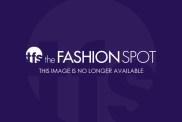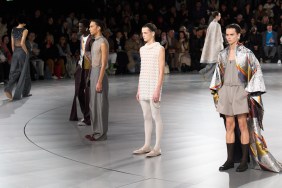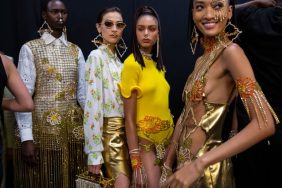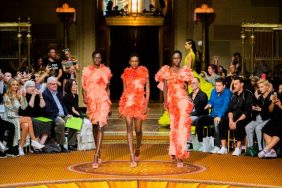Just as Pop Art challenged traditional fine art values after World War II, newly mass-produced fashions fueled by consumerism emerged to usurp fashion as a pastime for only the elite.

Paintings from an exhibition of works by American Pop Art artist Roy Lichtenstein, capturing the tongue-in-cheek nature of Pop Art; Image: WENN.com
In the mid-1950s, Pop Art had sacked the prevailing hierarchy of culture by celebrating commonplace objects and everyday life. A painting of a can of Campbell’s soup suddenly had the appeal of a Henri Matisse. At the same time, inexpensive retailers like Marks & Spencer began taking over from Parisian designers who had dominated the markets with expensive haute couture. It only made sense then that fashion designers eagerly began adopting the bold expressionism chief to the Pop Art aesthetic and using its irony to democratize fashion for the masses. Goodbye dull black and navy tailored suits, hello punchy bright print miniskirts.

Yves Saint Laurent, Pierre Bergé and Andy Warhol at a party together in 1977; Image: Michel Dufour/WireImage/Getty Images
We often see fashion designers referencing eras of art or taking elements of design from art to create clothing or even directly sampling prints and paintings in their textiles (here’s looking at you, Raf Simons). Commercial partnerships are also commonly formed these days where designers collaborate directly with artists on their collections. This synergistic fusing of creative talent wasn’t always the norm, however. Rather it was during the Pop Art era that fashion designers and artists began socializing in the same circles, influencing one another and sharing a culture.

Andy Warhol’s paper throwaway The Souper Dress modeled on Campbell’s Soup labels; Image: LOUISA GOULIAMAKI/AFP/Getty Images
Andy Warhol was one of these mingling artists who developed tight-knit friendships with designers. Long before Taylor Swift was forming famous friendships and building a squad, Warhol was hosting celebrity-packed hangouts at his studio The Factory. Warhol began his career as a fashion illustrator for magazines like Vogue, so it made sense then that he was one of the first Pop Art icons to make a mark on the fashion world by turning his art into paper dresses. As a disposable garment, the paper dresses were the ultimate statement on consumerist lifestyles with his Campbell’s The Souper Dress becoming the most recognizable and popular.
Later on, fashion designers began incorporating his prints on their garments, like Gianni Versace for his Spring 1991 collection and thereafter Christian Dior as well. Long before those collections, however, Warhol’s good friend Yves Saint Laurent produced a show in 1966 titled the Pop Art collection that openly referenced this art revolution. His lively, everyday accessible collection was a big success, proving that fashion is best enjoyed when you can have a little fun with it.

Jeremy Scott’s Moschino Fall 2014 fashion show was an ode to consumerism and pop culture; Image: Imaxtree
Since Saint Laurent’s collection, fashion continued to evolve more toward a format to be enjoyed by everyone in a more wearable and affordable manner. Some designers have even emerged that base their overall design philosophy on this democratizing of fashion — a direct salute to the values underlying the contemporary Pop Art movement. This includes fashion designer Jeremy Scott, whose Fall 2014 Moschino collection heavily referenced Pop Art by saluting heavyweight commercial deities Frito-Lay and McDonald’s in his designs.

Fashion continues to embrace Pop Art like at the Agatha Ruiz de la Prada show during Mercedes-Benz Fashion Week Madrid Spring 2015; Image: Carlos Alvarez/Getty Images
Even today, decades after its revolution, there are no signs of Pop Art’s self-referencing streak ending, with massive brands like Nike and Vans incorporating sketches from Roy Lichtenstein in their sneakers and runners. Due to its immense popularity rooted in the universal language of consumerism and its happy-go-lucky, eye-grabbing designs, Pop Art continues to be the most referenced art movement in fashion.







